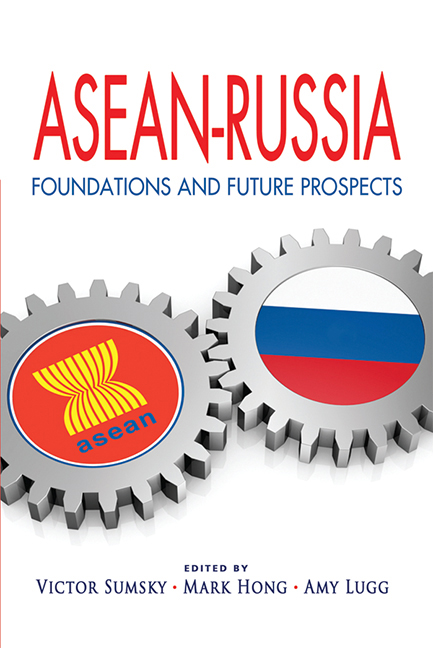Book contents
- Frontmatter
- Contents
- Foreword
- Preface
- About the Contributors
- Keynote Address
- Opening Remarks
- Keynote Address
- Introduction: Russia and the ASEAN Member States: Political and Economic Cooperation in Progress
- SECTION I WISEMEN'S VIEWS
- From Energy Partnership to Comprehensive Security in the Asia Pacific
- The Rise of Asia and Russia's Options
- ASEAN Regionalism and the Future of ASEAN-Russia Relations
- Thoughts on Asian Community Building
- Welcoming Russia's Participation
- SECTION II GEOPOLITICS
- SECTION III BILATERAL RELATIONS
- SECTION IV Business and Economics
- SECTION V CULTURE AND EDUCATION
- EPILOGUE
- Index
The Rise of Asia and Russia's Options
from SECTION I - WISEMEN'S VIEWS
Published online by Cambridge University Press: 21 October 2015
- Frontmatter
- Contents
- Foreword
- Preface
- About the Contributors
- Keynote Address
- Opening Remarks
- Keynote Address
- Introduction: Russia and the ASEAN Member States: Political and Economic Cooperation in Progress
- SECTION I WISEMEN'S VIEWS
- From Energy Partnership to Comprehensive Security in the Asia Pacific
- The Rise of Asia and Russia's Options
- ASEAN Regionalism and the Future of ASEAN-Russia Relations
- Thoughts on Asian Community Building
- Welcoming Russia's Participation
- SECTION II GEOPOLITICS
- SECTION III BILATERAL RELATIONS
- SECTION IV Business and Economics
- SECTION V CULTURE AND EDUCATION
- EPILOGUE
- Index
Summary
OVERVIEW OF REGIONAL COOPERATION
A notable feature — conspicuous by its absence — is the lack of perception of Russia threatening regional peace and stability. Previously, during the Cold War, the Asia-Pacific region was divided between the two camps, and members of one side would perceive the other great power as a security threat. The ending of such perceptions of Russia is a relatively new trend, and it signifies Russia's post-cold war transformation. This does not in any way diminish the reality of Russia's profound nuclear and strong conventional military capabilities, factors that will ensure Russia's strategic significance for decades.
Yet perceptions of Russia's current and future roles differ between Southeast and Northeast Asia. Whereas Southeast Asian countries tend to see post-cold war Russia as a distant but big power with which they want to have dialogue and relations of “equidistance”; the outlook is different in Northeast Asia, where tangible strategic interests and challenges involve Russia and regional countries. In this region, the most challenging issues are the Northern Territories dispute with Japan and the Korean Peninsula problems. Northeast Asia also includes Russia's most notable foreign policy success in the Asia Pacific — its “strategic partnership” with China.
One key question is: how should Asian countries engage Russia in the Asia Pacific? One way perhaps is to help develop the Russian Far East's economy as the key to integrating Russia successfully in the Asia Pacific. One approach is through energy cooperation: the energy resources of the Russian Far East and Siberia are so great and valuable that they could alleviate the Asia-Pacific region's dependence on Middle Eastern oil. Russia's current stable domestic situation — as compared to the Middle East Arab states faced with domestic turmoil — increases the attractiveness of Siberian energy resources to Asia-Pacific countries. But in general, Russia's engagement with the Asia Pacific will only realize its full potential once Russia is actively engaged in the region. Russia's place in the Asia-Pacific region (APR) is as yet not well defined, hovering between Moscow's grand visions of its geopolitical role in balance of power strategies, and Russia's sometimes “low profile” in the region.
- Type
- Chapter
- Information
- ASEAN-RussiaFoundations and Future Prospects, pp. 8 - 21Publisher: ISEAS–Yusof Ishak InstitutePrint publication year: 2012



